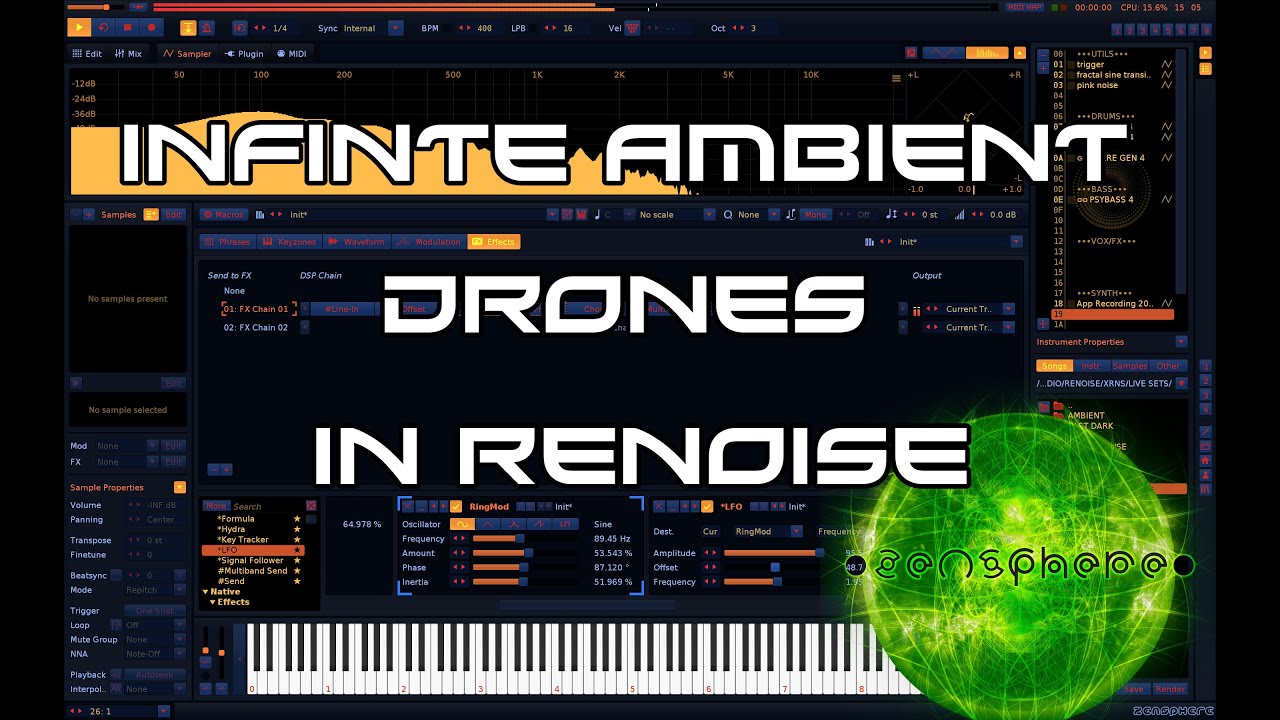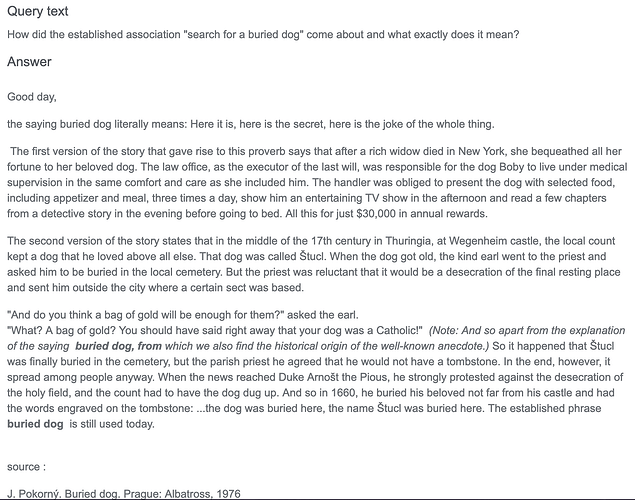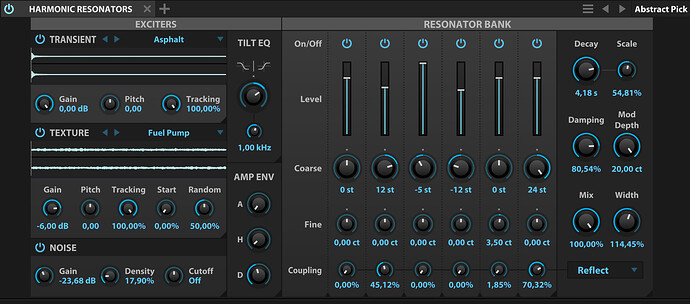Is it possible to apply these techniques in Renoise without using external vsts ?
Somehow I can’t even get close to it,
I’ll hard-select the frequency of the filtered notes for EQ, but it’s still not the same.
Any idea ?
Thanks
yes, you can do it, but you have to stack eq bands, since each one only boosts 20db. I made a harmonic extractor doofer a long time ago that uses the same sort of idea
EQ&FLT - HARMONIC EXTRACTOR.xrdp (31.9 KB)
The idea with this doofer is to apply it to a sample that contains some interesting noise or texture or ambience, then boost the harmonics of A 440 (octaves, even harmonics, odd harmonics) using stacked eq devices within the doofer. Then resample it to have a harmonic version of your noise/texture/ambience for use as a tonal instrument
resonant filter/eq bands can create some nice tones, but it’s often simpler to just use sine waves if that’s the type of sound you are after.
you can do some cool infinite drones with renoise pretty easily (if that’s what you’re after) using the line input device and ring mods, too. check this video if you haven’t seen it already:
“a secret sound design trick that no-one is talking about” yet has been in continual use for at least 50 years. I so hate clickbaiting hype talk like that…
Anyways, stacking Renoise EQs like MrZensphere said with low Q values. Sadly the Renoise EQ doesn’t allow you to enter note names so you’ll have to enter the frequencies of the notes you want. Luckily there is an easy chart for that.
You’re not limited to white noise though. I often have field recordings layered into my sound. I often employ this method to turn it into something with tonal content. It’s powerful stuff.
Related to this, and this is another thing that no-one talks about. ![]()
If you find yourself working a particular key you can reduce all the frequencies of notes not in that key. This can often create some space in your mix. Especially when it comes to real world recordings.
Yes, in the EQ I used the frequency of the notes I wanted, but somehow I didn’t think of using more of the EQ ![]()
I can’t blame the title of the video, if it was bullshit I wouldn’t even play it, but I was intrigued by this, whatever the title.
Unfortunately, this is a recent trend and it cannot be avoided. This is like when someone writes a new text editor and writes that the created text can also be saved.
Maybe just use a proper vst instead, e.g. a resonator? Saves a lot of time and the result quite likely will sound better.
The buried dog is elsewhere.
If it works natively, I’m able to (hopefully) do it via API.
What is this idiom? What does it mean and where is it from? I like it ![]()
Ah ok, didn’t fully read your first post ![]() So there does not seem to be another way than stacking EQ5 just like zen wrote, if you want to stay vanilla.
So there does not seem to be another way than stacking EQ5 just like zen wrote, if you want to stay vanilla.
If not so exact curves are ok, you also could use Filter 2 like so
or Chorus 2 like this
Or maybe just process the sampledata using lua then? The algorithm must be very basic, of course very slow then.
I’ve known this idiom since I was little.
The saying buried dog literally means: Here it is, here is the secret, here is the joke of the whole thing.
If you want to know where it comes from, the best explanation is probably here.
Unfortunately, you have to translate it yourself.
Hello friend.
Do I understand correctly it is about tuning EQ5/10 peaks to note frequencies to shape noise?
I have made a tuned keytracking library, and it also includes a formula device preset that can track the EQ peaks frequencies from a Key Tracker device.
Look here, this library will install some doofer presets which don’t include the EQ, but also a lot of formula device presets for various devices which include the formula for the EQ freqs!
The formula device preset in question is called “Ktrk1.1 - TrkEQ”
You have to set up a Key Tracker device, set it to full range (C-0 to B-9), and hook it into the “Key” macro of the formula device that has the preset loaded.
Then the formula device can track an EQ peak frequency, and it will be perfectly in tune to the note from the key tracker!
You cannot track the frequencies polyphonic, so if you want to real-time shape the noise with multiple voices, you have to make a dummy instrument for each voice and program it for a key tracker->formula-device->EQ frequency chain for each voice.
You can of course also just use a single tracker/formula, let it set a note frequency by hitting the note on keys, then setting the formula to control another EQ tap frequency, until you have each tap set up to it’s dedicated note/frequency, then resampling the result.
The doofer has further controls if you look into the code window and scroll down, for example the “fromnote” and “tonote” can set up a different keytracker range, you can modify bend and detune controls and transpose, trigger a harmonic of the note frequency, or change the A4-frequency.
Hope you have fun with this!
Oops, thanks.
I’ll look into it later.
I thought of using a keytracker where I will convert the range of notes to frequencies and then to EQ.
I haven’t figured it out yet, but somehow the script in Formula doesn’t work as it should.
It works in the external editor, but here it gives crazy results ![]()
I always use these conversions.
here is a simple attempt
Keys2Freq.xrdp (9.3 KB)
nice thing about an EQ with a good readout like Pro Q is you can take an audio sample and ‘trace’ the resonant peaks with eq spikes and capture the partials / tonal makeup of the source audio. works great for inharmomic percussive stuff.
FYI Falcon 3 (on sale for 199 currently) has a “Harmonic Resonator” osc module now, looks like this:
nice. not seen coupling in any larger banks like that only ever in more specific models like chromaphone.
can anyone explain in laymans terms how to implement that behavior from scratch? eg if i have say two resonant peaks or sine waves - can we couple them using native renoise tools?
Hi! I’ve done some fiddling to get a keytracked tunable EQ in renoise native. Tuning with formula devices. Turned out dead end due to tech limitations, so I share before it’s really ripe.
Well, it was a fun workout to do, but the result, even if it sounds great, is not usable. I had to use too many formula devices for it, and this bogs down renoise and makes it unstable.
You theoretically could use it in realtime, as the realtime tuning pitch track, bend etc. all is in place and “works”. When trying to make a song with like 5 or 6 of the devices in different instruments, renoise wouldn’t let me work long until it crashed, and the cpu was massively bogged down even on a reasonably strong laptop cpu - due to meta device overload. Maybe this could get better if renoise used a JIT compiler for the formula device, and also there seems to be a long standing bug in the formula devices that can make them crash when you use a lot of them or use them with very high tick frequency (up bpm/lpb/tpl with complicated formula setups).
Anyways it might still be fun to play around with and and make some resampling sounds, so here it is
You have the 8 peaks of an EQ10 keytracked and tuned. There are always 2 peaks on the same frequency, doubling it to get more gain and to be able to detune them against each other. The doofer has some macros, for pitch bend, detune, inertia (slide between notes), Q of the peaks (don’t automate this), and a level for each of the 4 doubled peaks. Inside you can bind the keytracker to a specific instrument, and you can set a note transpose value and a harmonic value for each of the four doubled peaks. You can also set a bend and keytracker range (must match the keytracker device), and you can change the a4 tuning frequency globally. To change these values just edit the visible variables in the code windows of the opened formula devices. Better leave all the collapsed devices alone.
Here is the little beast. Better only use one or two at a time, resampling sounds from it or it will kill your CPU…
fourpeaks 1.xrdp (184.5 KB)
Here you can have a more simple setup with a single keytracked peak, to build your own sounds from it. This method is less prone to crash renoise:
Ktrk 1.1 - EQ Peak.xrdp (9.0 KB)




